A Nova Scotia man who fishes within the Minas Basin says he routinely sees the harm defective culverts trigger to fish.
In some instances, says Darren Porter, the outcomes are lethal.
Porter, a industrial fisherman and environmentalist, factors to a pair of culverts within the Midway River close to Hantsport, NS, the place robust currents throughout excessive tide drive fish via them with such pressure that they’ll maim and even kill them.
“Think about the fish being pulled or pushed via this,” he stated. “It’s inhumane.”
Porter documented fish accidents in pictures that reveal deep wounds, hemorrhages and even prolapse, the protrusion of inner organs attributable to trauma.
Faulty Manholes are removed from a uncommon downside. Thomas Sweeney, habitat biologist with the Nova Scotia Salmon Affiliation, says between 50 and 60 per cent of Nova Scotia’s 31,000 water crossings – the place roads cross streams or rivers – trigger issues for fish passage.
ONE 2023 Canada Fisheries and Oceans Report discovered comparable outcomes: between 45 and 57 % of culverts in 4 main Nova Scotia watersheds — Annapolis, Shubenacadie, St. Mary’s and LaHave — have been labeled as fish obstacles.
“In some ways, it is loss of life by a thousand cuts. When [the fish] attain obstacles, their populations are threatened in a big a part of their distribution space”, stated Sweeney, including that migratory species, equivalent to salmon, are essentially the most affected.

Issues can embody storm drains which might be broken, blocked by particles or poorly designed, or not permitting sufficient water to move via or an excessive amount of water operating at excessive speeds.
Porter needs DFO to carry culvert house owners accountable by extra actively implementing the Fisheries Act, particularly Section 35 which prohibits harming or destroying fish habitat. Violating this part may end up in heavy fines and even imprisonment.
“When you begin implementing the legislation, folks begin implementing it,” he stated. “As soon as folks come into compliance, we resolve the issue. It is quite simple. Till that occurs, we’re lifeless within the water.”
Manhole house owners could be authorities businesses, municipalities, industries or non-public property house owners.
The Nova Scotia Division of Public Works, which owns lots of the province’s culverts, confirmed it doesn’t monitor what number of negatively affect fish passage.
“When the Division of Public Works receives a request from DFO, we make the required adjustments. We don’t monitor the quantity or kind of requests we obtain,” a division spokesperson stated in an e-mail, declining additional remark.

A DFO spokesperson stated that when the division turns into conscious of an obstructed culvert, it might order the culvert proprietor to take corrective motion inside a selected time-frame.
“Whereas voluntary compliance is the popular and anticipated strategy, enforcement actions and costs could also be imposed when circumstances warrant – particularly if a proponent fails to fulfill the necessities vital to realize compliance,” the spokesperson stated in an e-mail.
When requested by CBC Information what number of documented violations of the Fisheries Act over the previous 10 years have concerned culverts, DFO stated that “present information methods do not need the power to isolate or establish which particular incidents concerned dams or culverts.”
CBC Information requested DFO for an interview, however the division was unable to accommodate it.
Requests higher monitoring
Sweeney stated higher monitoring may a minimum of make the issue extra manageable and provides businesses the power to prioritize which culverts to repair on a restricted finances.
He stated folks may play a task via packages undertake a circulate who can prepare them on methods to consider manholes and file them on a database.
“If we take this big, insurmountable downside and begin breaking it down watershed by watershed, even tributary by tributary, that’s how we transfer ahead.”
MORE TOP STORIES

Leave a Reply